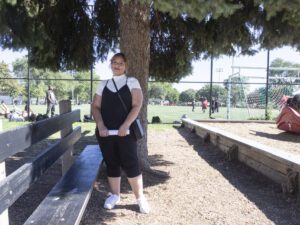 Veronica Martinez/Cicero Independiente
Veronica Martinez/Cicero IndependienteAs Cicero pushes forward with plans for a $2.7 million inclusive park, concerns are growing over toxic soil removal and environmental risks at the former industrial site, raising questions about the safety of the community’s newest green space.
This story is part of a collaborative reporting project led by the Institute for Nonprofit News and includes Borderless Magazine, Cicero Independiente and Inside Climate News. It was supported by the Field Foundation and INN.

Cicero’s vision for a new inclusive park is stirring concern as the town transforms a former industrial site into a playground accessible for children of all abilities. Despite its inclusive aim, the project, which started construction planning in August, is raising alarms among local residents and experts about how the town is handling toxic soil beneath the surface.
While the $2.7 million project promises much-needed green space to combat rising temperatures from climate change, concerns linger about multiple environmental challenges, including toxic contaminants still on site, such as arsenic and lead, pollution, flooding, and the site’s low 12% tree canopy coverage — well below the recommended 40%.
Documents from the Illinois Environmental Protection Agency obtained by Cicero Independiente through a Freedom of Information Act request detail the site cleanup plan for the Phil Fuentes Ability Park, at 1844 S. Laramie Ave. The plan targets “hot spot” contaminants in the northern and western areas of the site, where Volatile Organic Compounds (VOCs) and Polychlorinated Biphenyls (PCBs) were found. Both are harmful chemicals that are used in electrical and construction equipment.
News that puts power under the spotlight and communities at the center.
Sign up for our free newsletter and get updates twice a week.
Gerardo Morales, a Cicero resident who lives nearby, said he sometimes walks his children and dogs near the site without knowing its contaminated history. He hadn’t heard about the park.
“If they really want to build the park, they’re going to have to clean up and fix things, and make sure everything is safe and that the park is good for people,” Morales said.
According to the remediation plan, contaminated soil will be dug out to a depth of 3 feet and replaced with topsoil and fill soil. Excavators and hauling trucks will remove about 242 cubic yards of soil, which will be taken to a hazardous waste landfill. In addition, pavement may be applied to block leftover toxins.
Kimberly Gray, a professor with the Department of Civil and Environmental Engineering at Northwestern University, said the hotspot removal approach is not enough to protect against contamination risks. She also mentioned that the clean-up process involves institutional controls, such as using pavement to block toxins, that limit how a property can be used to prevent contaminant exposure.
“Institutional controls historically don’t usually work,” Gray said. “They’re not a permanent solution. They tend to eliminate exposure in the short term, but the minute that institutional control or that cap is breached, it doesn’t function. So, if you have a concrete area and it cracks, then you breach that control. it’s just a cheap way to get around having to do [more cleanup].”
Aaron Packman, a professor of Civil and Environmental Engineering at Northwestern University, explained the complexity of cleaning up contaminated sites.
“Sometimes, depending on the contamination, It can be highly localized,” Packman said. “If it’s everywhere, it’s easy to find. If it’s some pockets of [contamination] that have high concentration, it’s hard to find.”
Digging Up a Toxic Past
Ability Park’s site has a controversial history. Home to the Blakeslee dishwasher factory, which operated from the early 20th century to the mid-2000s, it then housed S.G.I., a concrete excavation and wrecking company. It was also used for lumber yards, a door manufacturing company and a coal factory.
Between 2009 and 2011, K-Plus Environmental Services, a Chicago-based environmental consulting and engineering company, found hazardous contaminants at the site, which still remain. Those hazardous contaminants include arsenic exceeding safe limits, lead and vinyl chloride. The site contained other debris, including tree trunks and abandoned vehicles.
Arsenic is linked to lung and skin cancer and can be inhaled or ingested by children, while lead can cause learning disabilities and behavior problems in children. These risks are especially concerning for children with disabilities, who may be more vulnerable to these toxins and face a higher risk of hospitalization.
Read More of Our Coverage
Specialty Consulting, a Chicago engineering firm that is the environmental consultant for the Ability Park site’s cleanup, stated that the current remediation plan follows state regulations. Arturo Saenz, CEO and project manager, previously oversaw environmental services for the Crawford coal plant project. According to Free Spirit Media, during a Chicago City Council meeting on March 1, 2019, Saenz praised Hilco, the owner of the Crawford plant, for choosing GSG Consultants — where he was a principal at the time — to work on the demolition.
The coal plant faced public backlash after a botched smokestack implosion in Little Village resulted in widespread dust exposure. Hilco agreed to settle a class-action lawsuit brought by Little Village residents for $12.25 million, but the company did not admit any wrongdoing.
Saenz did not respond to a request for comment.
The park will be constructed by Terra Engineering, with design input from the disability service organization United Cerebral Palsy Seguin of Greater Chicago and the Special Education departments of Cicero School Districts 201 and 99.
According to the remediation action plan for the park project, arsenic levels will be managed through a combination of hotspot removal and contaminant averaging, rather than complete removal.
The remediation plan concerns experts like Gray, who pointed out the risks associated with contaminant averaging.
“What I’m concerned about is that [consultants] are taking individual concentration measurements and then averaging across the site,” Gray said. “My concern is that when you average something, it removes high values [of] contaminants.”
Contaminated groundwater also won’t be removed. Restrictions, including a ban on new wells and town rules that prevent its use for drinking, will limit exposure to harmful substances like vinyl chloride and lead.
However, heavy rains could raise groundwater levels and overwhelm the sewer system, spreading existing contaminants.
“If the groundwater is pretty shallow and this is an area that’s subject to any flooding or ponding, you can get a release of that groundwater into surface water exposure,” Gray said. “That would be the concern.”
During the site investigation, groundwater was found between 9.9 and 15.8 feet below the surface, confirming it is shallow and could rise during floods.
“We often get a lot of surface flooding, and if there’s contaminated soil, flooding moves it around,” Packman said. “It’s something we can’t easily avoid.”
Cicero Independiente was unable to obtain cleanup and design plans from Specialty Consulting for the site, originally referred to as Inclusion Park. When reporters contacted the firm for details on the remediation plan, a representative said the project wasn’t on file, even though construction was already in the planning stages.
In addition, the Town of Cicero did not respond to requests for comment regarding park clean up and construction planning.
Ribbon Cut, Community Left Out

After a published notice about the project in March 2023 in the Lawndale News, Cicero Housing Authority made the project details available for review in person and on the town’s website. Cicero officials hosted a groundbreaking at Phil Fuentes Ability Park on Sept. 23. Attendees included representatives from the U.S. Department of Housing, State Sen. Mike Porfirio and Cicero Town President Larry Dominick.
While residents interviewed outside their homes said creating a new park is positive for kids, they felt left out of learning important details about the project and providing input.
The Town of Cicero declined to respond to questions about how it planned to involve community members in the planning process for the park. Jose Castellanos, a Cicero resident near the park site, said he finds it difficult to find news from the Town of Cicero and added that he didn’t know about the park project. He’s interested in learning more because his toddler has a disability.
“I [was curious] if [the future park] was one of those autism parks or something similar,” Castellanos said. “I would like something like that for my son. He’s actually a little bit on the spectrum.”
Castellanos said he would appreciate an inclusive space, but the contamination concerns him.
While Cicero tackles the challenges at the site, numerous communities across the U.S. have successfully revitalized former industrial areas into vibrant, climate-friendly green spaces.
For instance, Discovery Green Park in Houston, Texas, was built on a former railway yard and parking lot. The park not only addressed contamination through extensive clean-up efforts but also integrated stormwater management, solar panels and shaded green spaces to help mitigate the urban heat island effect. In Hoboken, New Jersey, officials have created a 5-acre park that doubles as a storage area for roughly 2 million gallons of stormwater runoff, according to Inside Climate News.
Meanwhile, in Chicago, the Urban Growers Collective (UGC) is converting vacant lots into urban farms on the South and West Sides. According to Erika Allen, CEO of the collective, youth are a key part of the organization’s work, learning farming and sustainability through hands-on experience.
“Our young people, especially this upcoming generation, they’re inheriting all of this contamination and an environment that is challenged with climate change,” Allen said. “We’re really preparing things for them, to get them involved to make sure that they’re educated early, so that they’re involved in [remediating and cleaning] their environment.”
Pedro Garcia has lived in Cicero for three decades. When informed about the site’s contaminated past and the new park plans, he was shocked.
“If I knew that the park had some kind of contamination, then of course, I would be very aware,” Garcia said. “And I wouldn’t take my kids there for their protection. But if I knew that everything was safe and there were no problems, then of course, I would encourage them to go but just to be very careful.”
This story was produced by Cicero Independiente.


